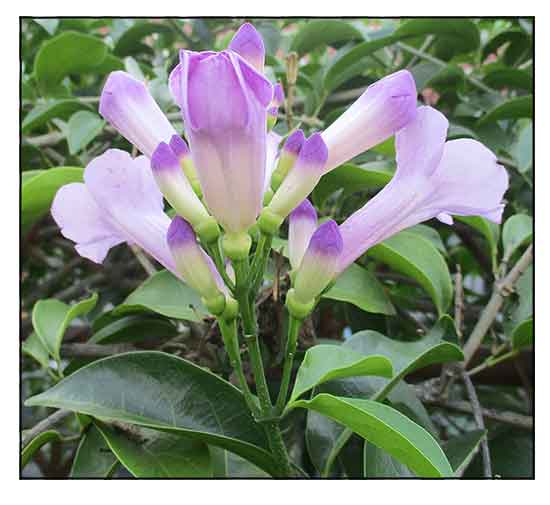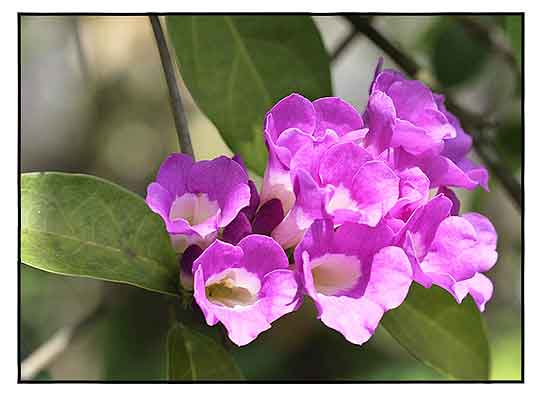 Gen info Gen info
- Mansoa alliacea, or garlic vine, is a species of tropical liana in the family Bignoniaceae. It is native to northern South America.
- Among the mestizos of the Amazon rainforest, is called ajo sacha, a Spanish-Quechua name that means "forest garlic" or "wild garlic".
- Etymology: The genus name Mansoa honors Antonio Luiz Patricio da Silva Manso (1788-1848), a Brazilian botanist, physician, and politician. (It was first described and published in Biblioth: Universelle Geneve, ser.2. Vol 17 in 1838.) (15) The species epithet alliaceae derived from Latin alliaceus, a, um meaning "similar to garlic", referring to the garlic odor emitted when the leaves are rubbed. (17)
Botany
Pachyptera alliacea is a shrubby vine, with numerous woody vines from the roots that grow 2 to 3 meters to a shrub-like appearance. Leaves are ovate, up to 15 centimeters long, with acute tip, leathery, dull to bright green. Flowers are in clusters, borne at the axils of leaves. Petals are usually deep lavender, with a white throat that fade to a pale lavender, then to almost white.
 Mansoa alliacea is a shrub or evergreen semi-woody creeper with 2-3 m long stems and young branches with almost quadrangular section. The leaves, on a 0,7-1,5 cm long petiole, are opposite, bifoliate, often with a simple 5-20 cm long tendril between the leaflets. Leaflets on a 0,5-1,2 cm long petiolule, oblong-ovate with obtuse or acuminate apex and entire margin, 10-20 cm long and 3-9 cm broad, coriaceous, with the leaf blades on the sides of the central nervation slightly curved turned upwards and apex curved downwards, of intense green color and glossy above; the rubbed leaves emit a strong smell of garlic. Axillary or terminal panicle inflorescences, on a 0,8-1,5 cm long peduncle, bearing several imbutiform flowers of purple mauve color with white throat, tending pink and almost white with the time passing, 6,5-9 cm long and of 3-5 cm of diameter; the flower emits a delicate smell of garlic that can be felt only when very close to it. Campanulate calyx, 0,5-0,8 cm long, usually truncated at the apex or slightly five-toothed, of green color, corolla with 5-8 cm long tube and 5 roundish lobes, 1-2,5 cm long, and 4 didynamous stamens. The fruit is a flat linear capsule with rounded apex, 10-50 cm long and 1,5-2,4 cm broad; with the two faces crossed in the centreline by a thin crest, containing numerous seeds with two membranaceous wings, 1,8-6 cm long and 1-1,5 cm broad. (17) Mansoa alliacea is a shrub or evergreen semi-woody creeper with 2-3 m long stems and young branches with almost quadrangular section. The leaves, on a 0,7-1,5 cm long petiole, are opposite, bifoliate, often with a simple 5-20 cm long tendril between the leaflets. Leaflets on a 0,5-1,2 cm long petiolule, oblong-ovate with obtuse or acuminate apex and entire margin, 10-20 cm long and 3-9 cm broad, coriaceous, with the leaf blades on the sides of the central nervation slightly curved turned upwards and apex curved downwards, of intense green color and glossy above; the rubbed leaves emit a strong smell of garlic. Axillary or terminal panicle inflorescences, on a 0,8-1,5 cm long peduncle, bearing several imbutiform flowers of purple mauve color with white throat, tending pink and almost white with the time passing, 6,5-9 cm long and of 3-5 cm of diameter; the flower emits a delicate smell of garlic that can be felt only when very close to it. Campanulate calyx, 0,5-0,8 cm long, usually truncated at the apex or slightly five-toothed, of green color, corolla with 5-8 cm long tube and 5 roundish lobes, 1-2,5 cm long, and 4 didynamous stamens. The fruit is a flat linear capsule with rounded apex, 10-50 cm long and 1,5-2,4 cm broad; with the two faces crossed in the centreline by a thin crest, containing numerous seeds with two membranaceous wings, 1,8-6 cm long and 1-1,5 cm broad. (17)
Distribution
- Introduced.
-
Naturalized in the Philippines.
- Native to the Amazon rainforest.
- Grown as ornamental in towns and cities.
Constituents
- Leaves and flowers yield beta sitosterol, stigmasterol, daucosterol, and fucosterol.
- As in garlic, sulfur compounds are also found - alliin and various allyl sulfides.
- Phytochemical study of aerial parts yielded steroids, terpenoids, and flavanoids.
- Study on essential oil of leaves
yielded diallyl disulfide (50.05%), diallyl sulfide (11.77%) and trisulfide di-2-propenyl (10.37%) as main compounds. (see study below) (10)
- Quantitative analysis of different plant parts showed the highest amount of phenol in leaf and flavonoids in roots. (13)
- Study isolated a new cytotoxic naphthoquinone, 4-hydroxy-0-methoxy-α-lapachone, along with 9-methoxy-α-lapachone. (14)
- Study of 95% ethanol extract of leaves and twigs isolated two new pyranonaphthoquinones, 8,9-dimethoxy-α-lapachone (mansonin A) ( 1), and 7-hydroxy-8,9-dimethoxy-α-lapachone (mansonin B) ( 2). (20)
- GC-MS analysis of ethyl acetate extract from dried and coarsely powdered leaves yielded five chemical ingredients, namely:
Neophytadiene (1.89%), Phytol (29.30%), Phytol acetate (3.54%), Squalene (59.58%) and dl-alpha-Tocopherol (5.69%) and organosulphur compounds. (21)
 Properties Properties
- Leaves when crushed emit an odor of garlic, with a hint of onion.
- Considered analgesic, anti-inflammatory, anti-rheumatic, febrifuge, antitussive.
- Pharmacologic findings suggest anti-inflammatory, antitussive, anti-rheumatic, analgesic, febrifugal, muscle relaxant, uterine relaxant, and hypotensive properties.
- Studies have suggested antimicrobial, apoptotic, anticancer, larvicidal, antinociceptive, anti-inflammatory properties.
Parts used
Bark, roots, leaves.
Uses
Edibility
- In the tropics and Amazon rainforest, leaves are used as condiment or spice for its garlic flavor and odor.
- Leaves used for making tea.
Folkloric
- No reported folkloric medicinal use in the Philippines.
- Elsewhere, a common remedy for pain and inflammation of arthritis.
- Decoction or infusion of leaves
used for colds, flu, fever.
- Cold maceration and tincture of roots used as whole body tonic.
- In the Amazon, bark poultice used on bumps, inflammatory swellings. Infusion of bark or leaves used for rheumatism, arthritis, colds, uterine disorders, inflammation and epilepsy. Root prepared in cane alcohol tincture used as whole body tonic. The Amuesha use a leaf tea to aid fertility.
- Stem and leaf decoction for baths to treat fever, influenza, rheumatism, and colds. Decoction of stem fragments used as external wash to treat fatigue, lameness, and lumbago.
- Decoction of bark used for epilepsy.
- In Guiana, decoction of stems and leaves used as external wash for pains and muscular fatigue. Leaves used for constipation, nausea, and cough. Alcoholic maceration of root bark and leaves used for rheumatism and arthritis. Aqueous macerated roots used as tonic. Leaf infusion used for fever and cold. In Peru, dried leaves sued for cold, pneumonia, malaria, and as insecticidal. (22)
- In Venezuela, used as an emetic.
- In Suriname, used for colds, fever, rheumatic complaints, vermifuge, and as tonic in the last month of pregnancy. Decoction and infusion of bark used for general weakness. Dried aerial parts used as vermifuge.
Others
- Ritual: Mayans used it in rituals. Used for good luck and to drive evil spirits away. Used by fishermen for purification, to ensure a good catch. Also used in baths to attract wealth and prosperity. Shamans use it as an ingredient in hallucinogenic potions.
- Repellent: Burning of leaves used to repel bats and insects.
Studies
• Antimicrobial: P. alliacea was one of nine common plants studies in India for antimicrobial activity. Eight of 9 plants, including P. alliacea inhibited the growth of the test microorganisms (Aspergillus niger, Staphylococcus aureus and Escherichia coli). (5)
• Apoptosis / Anti-Breast Cancer: Methanol extract of A. alliaceum flowers was evaluated for growth inhibitory activity on estrogen receptor positive and estrogen receptor negative breast cancer cells by MTT assay. Results showed inhibition of both cancer cells through apoptosis induction, and suggests a potential pharmaceutical source of potent secondary anticancer metabolites. (6)
• Larvicidal Against Malaria Vector Anopheles stephensi: Study evaluated various extracts of Pseudocalymma alliaceum and Allium sativum against larvae of Anopheles stephensi. The hexane extract of P. alliaceum was more effective followed by hexane extract of A. sativum. (7)
• Larvicidal: Crude ethyl acetate extracts of Pseudocalymma alliaceum showed promising antifeedant, larvicidal and insect growth inhibitory activities against fourth instar larvae of Spodoptera litura and Helicoverpa armigera. (9)
• Larvicidal / Mosquito Vector / Leaf Essential Oil: Study of various extracts of essential oil and hydrolate of leaves of P. alliaceum inhibited the normal growth and development of mosquito larvae of Culex quinquefasciatus, prolonging and delaying larva and pupal duration. (see constituents above) (10)
• Antinociceptive / Anti-Inflammatory: Study evaluated the anti-inflammatory and antinociceptive potential of M. alliacea extract in an inflammatory pain model through plantar injection of complete Freund's adjuvant (CFA) in mice. Chromatographic analysis of the extract yielded p-coumaric, ferulic, and chlorogenic acids, luteolin, and apigenin. Extract treatment prevented and reversed CFA-induced mechanical allodynia with maximum inhibition (Imax) of 100% and 90±10% respectively. The extract did not induce adverse effects commonly associated with opioids and analgesic drugs. Results suggest antinociceptive activity without causing adverse effects in tested phamacological doses. The effect may be mediated via δ -opioid receptors. (18)
• Effect on Embryonic and Tumorigenic Mouse Cell Lines / Leaves: Low doses of water extract of M. alliacea leaves were applied to cancerous and non cell line. Extract applied to T3-HA cancer cells inhibited growth, and higher doses destroyed colonies of cancer cells. Administration of extract to NIH Swiss mouse cell cultures showed growth inhibition at higher doses, but at concentration of 10.14 mg/ml, cell growth began to increase after three days. Results suggest the extract selectively targets T3-HA mouse cancer cells but not NIH Swiss embryonic mouse cells. (19)
• Anthelmintic: Study evaluated the anthelmintic activity against Pheretima posthuma and phyto-derived anthelmintic substances from M. alliacea against the enzyme ß-tubulin and the molecular basis of its function using Invitro and Insilico methods. Tests showed the methanol extract has dose-dependent anthelmintic efficacy at various levels. In silico studies suggest four phytochemicals from methanol extract of M. alliacea i.e., Apigenin-7-O-methylglucuronide, Scutellarin, Luteolin, and Ursolic acid are very likely against ß-tubulin. (23)
Availability
- Wild-crafted.
- Ajos sacha capsules and tinctures in the cybermarket.
- Ingredient in herbal formulations for cold, flu, pain and inflammation.
|

![]()






